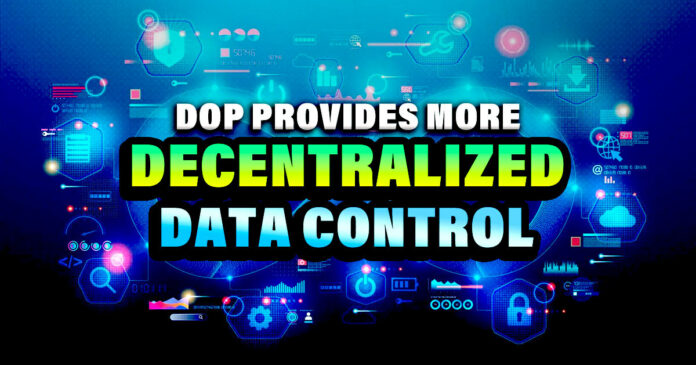The Web3 future will all be about control over your data. Many layer 2 solutions and layer 1 chains are catering to this. Most often, they use privacy in their marketing. That’s where DOP or the Data Ownership Protocol is different.
Their name already implies what they are offering. That’s right, DOP offers data ownership. So, let’s find out how the Data Ownership Protocol differs from layer 1 chains and layer 2 solutions.
(1/4) We’re excited to release a demo of Phase 1 of the DOP protocol on Ethereum! This video shows initial capabilities like encrypted transfers – the core technology on the road to data ownership and selective transparency. pic.twitter.com/hZBiH5Gwoo
— Data Ownership Protocol (@dop_org) October 12, 2023
How Most Layer 2 Protocols Offer Privacy Whilst Using zk Tech
Layer 2 solutions build on top of Ethereum as a blockchain. This allows them to offer faster and cheaper transactions compared to Ethereum. Scalability is another advantage that an L2 offers. This is very handy, and platforms with diverse backgrounds use L2s for these reasons. For example,
- Blockchain gaming – these games need fast and cheap transactions. In case they become popular, with more users, they need to scale.
- DeFi – DEXes, lending platforms, liquid staking, they all need fast and cheap transactions.
- NFTs – Minting or selling and buying NFTs, also requires fast and cheap transactions. You don’t want to miss out on a sale or mint, due to a slow transaction.
Now, L2 solutions can be blockchains or sidechains built on top of Ethereum. But not necessarily. One thing they have in common is that they use zk proofs (ZKPs) when offering privacy. So, they need to send transactions to Ethereum for final settlement. Sending single transactions would not make sense. By doing that, they lose the advantage of being cheap and fast. Instead, they bundle batches of transactions and send these to Ethereum. Here the Layer 1, Ethereum in this case, can settle the transactions.
Sequencers
This is where the tricky part comes into play. To send these bundled batches, L2s use sequencers. These sequencers work like traffic police officers. They control and can deal with busy traffic situations. For example, a sequencer handles various tasks for transactions,
- Verifying.
- Ordering.
- Compressing.
- Batching.
However, in these sequencers also lies the first potential problem. These sequencers are all centralized. In other words, there’s a potential single point of failure. Decentralized options are in the making, but they’re not in use yet. Currently, they’re not fast enough and still have security issues.
Furthermore, there’s an issue with MEVs or maximum extractable value. Because sequencers order the transactions, they can abuse this function. All transactions gather in a mempool. The more you pay the miners, the faster your transaction gets processed. In other words, the faster your transaction leaves the mempool on the way to final settlement.
Two ways of using MEV can slow transactions down. These are,
- Front running – bots look for profitable transactions. Once they find such a transaction, they duplicate it and add a higher gas fee. This leads to receiving order priority.
- Sandwich attack – this can happen with a large trade on a DEX. Trades are placed in front and behind the original trade. This affects the amount of crypto the original trader receives. The bad actor profits from the price difference.
However, a positive way of using MEV extraction is with arbitrage. This is when a cryptocurrency has a different price between two exchanges. You buy cheap on exchange ‘A’ and sell higher on exchange ‘B’ and pocket the difference. The benefit is that it aligns token prices across exchanges.
🚨Frontrunning protection doesn’t necessarily mean you won’t be frontrun.
Looking at a 60-day sample of public and private txns revealed some users who sent their txs privately incurred more slippage than those who sent publicly.
Why? 👇https://t.co/q7mfNPcAWp
— Blocknative | mempool.eth 🔮 (@blocknative) September 7, 2023
Fraud Proofs
A potential even bigger issue is the lack of fraud proofs. The fraud proofs are layer 1-based algorithms. These check if the layer 2 records transactions correctly. With fraud proofs, an L2 can temporarily use the security that Ethereum offers.
Now, Vitalik Buterin, one of Ethereum’s co-founders, wrote an article about this. He mentions the use of three stages. These three stages distinguish between the decentralization level of rollups. The levels go from zero to two.
So, in case of a rollup being a stage 0 rollup, it doesn’t have the Ethereum security. Instead, it asks its users to trust their own security. Now, in case of a sequencer failing, you can’t get your funds back onto Ethereum. There’s no exit from the layer 2.
Rollups that fall in this category are, for example, Optimism and Base. That’s because Base based its chain on Optimism. On the other hand, Arbitrum classifies as a stage 1 rollup because it has fraud proofs installed. However, it still uses a centralized sequencer.
So, to summarize the privacy options that L2s offer, there are still a few issues at hand. They use centralized sequencers and may not use fraud proofs. All this may put your funds at risk when using such a rollup.
Various Ways of Layer 1 Chains Offering Privacy Using zk Tech
Layer 1 chains can also offer privacy, whilst using zk technology. This privacy can come in a couple of ways. For example,
- zk Proofs (ZKPs).
- Secure multi-party computations (sMPC).
- Trusted execution environments (TEE).
For example, Aleph Zero uses a combination of ZKPs and sMPC. On the other hand, Secret Network on Cosmos, uses TEE. So, let’s find out how Aleph Zero offers privacy.
I know you are probably wondering where DOP fits in with all these options. I promise I’m getting to that in a second……
“I expect ZK-SNARKs to be a significant revolution as they permeate the mainstream world over the next 10-20 years.” – @VitalikButerin
But before then, Let’s talk about ZK Proof and what the heck it is.
In a world where we send information, transactions, and data via the… pic.twitter.com/9YWqJNjyaI
— Greyy 🏴 (@Greyypoet) October 31, 2023
Aleph Zero
Aleph Zero realizes that both ZKPs and sMPCs have shortcomings. Now, with ZKPs, Aleph Zero has the advantage that it is a layer 1 chain. Hence, it doesn’t need sequencers, like an L2 does.
To offer privacy, Aleph Zero will use ‘Liminal’. However, Liminal is not live yet. Nonetheless, Liminal will eventually allow for interchain privacy. For example, with Ethereum, Cosmos, or BNB.
As ZKPs, Aleph Zero plans on using zk-SNARKs. This is a zero-knowledge succinct non-interactive argument of knowledge. In this case, succinct means a proof that’s small and verifies fast. Non-interactive means that between the prover and verifier there’s no to limited interaction. The ‘arguments of knowledge’ part offers support for the computational system’s integrity.
However, a zk-SNARK has a few issues. For example,
- Transparency – they are not 100% transparent. They need a trusted setup phase.
- Scalability – there’s complex communication. To solve a problem between parties, it grows linearly and needs more messages.
- Quantum attacks – they are not safe from future quantum attacks.
- Multi-user action – they can’t deal with this. Smart contracts don’t update when more than one user transacts with it. We refer to this as the global private state.
That’s where sMPC comes to the rescue. It can keep sensitive information off-chain on various nodes. Data is only accessible with a secure handshake between all nodes. However, an sMPC is slow on its own. That’s why Liminal will only use sMPCs for the global private state computations. For all other computations, it uses zk-SNARKs.
So, Aleph Zero appears to make good use of ZK proofs. It uses a unique hybrid option. However, each option appears to have a potential weakness.
Last week, the team behind Liminal managed to optimize the proof generation time, reducing it by a factor of 4.
We have also signed agreements with five new projects in the EFP! Announcements are coming soon, after the projects reach their first milestones. pic.twitter.com/GS9f6DiH3t
— Aleph Zero (@Aleph__Zero) June 12, 2023
You end up having to ask yourself what tradeoffs are you willing to make for privacy and control.
DOP Offers Selective Transparency
Where does DOP, the Data Ownership Protocol, fit into all this?
So, instead of privacy, DOP offers selective transparency. You only share the data that you’re comfortable with. It’s you who controls how much information you share and with whom. For example, for your crypto wallet’s content. Read our introductory article on DOP here.
DOP does this differently compared to L2s and Layer 1s. For example, the devs built it directly on top of Ethereum. However, not like an L2 chain, but like a dApp. There are a couple of reasons why this makes more sense, for instance,
- It gives more “data control” coverage and options
- It could be more private if that’s what you choose
- You control your data while staying on the Ethereum mainnet. There’s no need for bridging.
- You have direct access to all the liquidity on ETH without loosing your privacy.
- Moving from Ethereum or EVM into a “data control” mode is easier when built on top instead of as an L2.
So, in contrast to L2s and L1s, DOP is not so much about privacy. Instead, it’s about you controlling what you share and with whom. And when. The emphasis here is that you are in control.
Our newest article explores how DOP delivers on @VitalikButerin‘s vision for balancing privacy and compliance on blockchains.
Read why DOP’s selective transparency aligns well with Buterin’s proposals for association sets and balancing over-transparency: https://t.co/7a8Wz1PlSt pic.twitter.com/Dh3YynfkTY— Data Ownership Protocol (@dop_org) October 19, 2023
Conclusion
We looked at the various ways you can use zk proof technology for privacy. This included Layer 2 solutions and layer 1 chains. However, what DOP offers is different. Instead of privacy, they offer transparency options, options that you control.
DOP does this in a decentralized way by building on top of Ethereum as a dApp. This is better and more decentralized than building an L2. These have centralized sequencers which could be logging your data. Or layer 1 chains, which also may have centralized parts in their set-up.
Disclaimer
The information discussed by Altcoin Buzz is not financial advice. This is for educational, entertainment and informational purposes only. Any information or strategies are thoughts and opinions relevant to accepted levels of risk tolerance of the writer/reviewers, and their risk tolerance may be different from yours.
We are not responsible for any losses that you may incur as a result of any investments directly or indirectly related to the information provided. Bitcoin and other cryptocurrencies are high-risk investments, so please do your due diligence. This article has been sponsored by DOP.
Copyright Altcoin Buzz Pte Ltd.





























